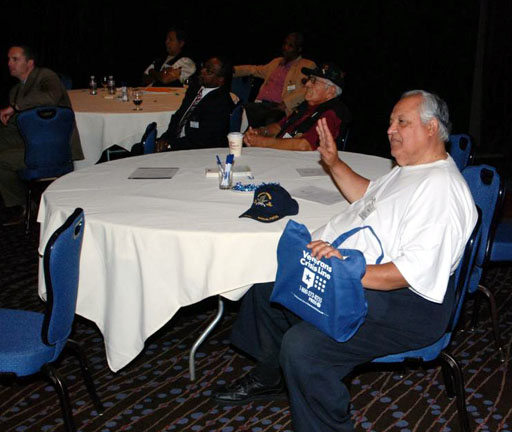Veterans
Affairs Office of Govt. Relations Outreach:
April 9-10, 2013 at Pala Casino
By Roy Cook
Pala Tribal land
and Casino is the location of the Veterans Administration-Indian Health
Service April 9-10, 2013 outreach to the Southern California Tribal Nations.
I pre-registered as a Vietnam era veteran with service connected disability.
I joined the Army (Airborne) in 1964 from Snookson (Tucson, Arizona) and
listed Tribal affiliation as Oodham from Wa ak.
There
were many informative workshops on past and current issues vital to the
interest and services earned by our Warriors in many of the theaters of
conflict and war over the years. American Indian communities have the
highest volunteer military status in relation to size of population of
any other culture group. There are over 200,000 Native American military
veterans today. It is well recognized that, historically, Native Americans
have the highest record of service per capita when compared to other ethnic
groups.
More than 12,000 Native Americans served during World War I, though they
weren't official U.S. citizens until 1924. More than 44,500 served in
World War II, a greater per-capita rate than any other ethnic group. More
than 50,000 served in Vietnam, 90 percent of them as volunteers.
Native
Americans serving as of April 1, 2003
Source: Immigration Policy Center
and U.S. Defense Department
Army
- 2,985 Eskimo - 98 Aleut - 79 = 3,162
Navy - 7,068 Eskimo - 116 Aleut - 199 = 7,383
USMC - 1,111 Eskimo - 30 Aleut - 31 = 1,172
USAF - 1,696 Eskimo - 30 Aleut - 22 = 1,748
US/Canadian Indians total = 12,860, plus
Eskimo - 274 & Aleut - 291 Total = 13, 425
Grand Total All Serving = 1,401,128
The reasons behind this amazing contribution are complex and deeply rooted
in traditional American Indian culture. In many respects, Native Americans
are no different from others who volunteer for military service. They
do, however, have distinctive cultural values that drive them to serve
their country. One such value is the warrior tradition. In part, the warrior
tradition is a willingness to engage the enemy in battle. This characteristic
has been clearly demonstrated by the courageous deeds of Native Americans
in combat. However, the warrior tradition is best exemplified by the following
qualities inherent to most Native American societies: courage, respect,
generosity and wisdom.
Many traditional cultures recognize that conflict disrupts the natural
order of life and causes a spiritual disharmony and many have a variation
of purification ceremony that are a part of the return to Native American
life in balance. To survive the chaos of war is to gain a more intimate
knowledge of life. Therefore, military service is an acceptable avenue
in Native American society.

This writer participated
as military historian and Native American heritage writer, under the direction
of Ernie Salgado and in collegial association representing the CALIE efforts
to support the Vietnam Wall tribute to the 230 fallen tribal warriors
on the Vietnam wall in Washington DC. Additionally I participated as the
secretary and historian for the American Indian Warriors Association veterans
group in San Diego. This Native American Veterans Benefit Summit gathering
is of vital and significant interest to our Tribal members and Brothers
in Arms.
Of particular note
are the Veterans Benefit Summit Workshops attended:
1. Post traumatic stress disorder, understanding PTSD and Trans-generational
PTSD.
2. Diabetes management.3. How to request a headstone, marker or medallion.
4. Overcoming barriers in serving AI/AN Veterans.
Tuesday
evening entertainment included the singing and Warriors dancing to the
songs of Gourd dance. Inspiration for the songs, according to the Kiowa
story, a Kiowa warrior, the lone survivor of a battle, is trying to find
his way back to the tribe. On his way, he hears music and finds a Red
Wolf, singing and dancing and holding a fan in one paw and a rattle in
the other. Red Wolf feeds the warrior and tells him to take the songs
back to the tribe. If you listen closely you will hear the call of the
wolf at the end of the songs.

Today, most dancers
are members of a gourd society. Many are Warriors and Military Veterans
of many conflicts. They wear a bandoleer of metal beads and mescal seeds.
Over their shoulders and tied to the other side in a cross body bandolier
manner, they drape a wool blanket, red on one end, blue on the other.
Some are plain and others are decorated with war ribbons and unit patches.
In one hand, they hold a fan of feathers, and in the other a rattle, sometimes
a gourd or metal can or saltshaker.


Additionally,
the Luiseno Bird songs and dancers were excellently explained and gracefully
presented. A man holding a gourd rattle was leading the singing. He stated
that earlier and on special occasions a turtle-shell rattle is utilized.
Both the sound of the gourds spinning and the singing were meditative
and spiritual. All the songs had words. The young women stood up and danced.
They held their feet together and their knees were somewhat bent, so that
their dress reached the ground. They held their hands together in front
of her, also as the women danced, some of the men stamped one foot on
the ground while uttering each time a growl or grunt in encouragement
of the song and dancers. Usually several women dance together on this
occasion.
Native American Veterans, Airborne, All the way!